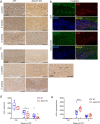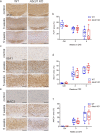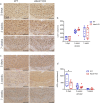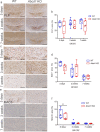Abcd1 deficiency accelerates cuprizone-induced oligodendrocyte loss and axonopathy in a demyelinating mouse model of X-linked adrenoleukodystrophy
- PMID: 37331971
- PMCID: PMC10276915
- DOI: 10.1186/s40478-023-01595-w
Abcd1 deficiency accelerates cuprizone-induced oligodendrocyte loss and axonopathy in a demyelinating mouse model of X-linked adrenoleukodystrophy
Abstract
X-linked adrenoleukodystrophy (X-ALD), the most frequent, inherited peroxisomal disease, is caused by mutations in the ABCD1 gene encoding a peroxisomal lipid transporter importing very long-chain fatty acids (VLCFAs) from the cytosol into peroxisomes for degradation via β-oxidation. ABCD1 deficiency results in accumulation of VLCFAs in tissues and body fluids of X-ALD patients with a wide range of phenotypic manifestations. The most severe variant, cerebral X-ALD (CALD) is characterized by progressive inflammation, loss of the myelin-producing oligodendrocytes and demyelination of the cerebral white matter. Whether the oligodendrocyte loss and demyelination in CALD are caused by a primary cell autonomous defect or injury to oligodendrocytes or by a secondary effect of the inflammatory reaction remains unresolved. To address the role of X-ALD oligodendrocytes in demyelinating pathophysiology, we combined the Abcd1 deficient X-ALD mouse model, in which VLCFAs accumulate without spontaneous demyelination, with the cuprizone model of toxic demyelination. In mice, the copper chelator cuprizone induces reproducible demyelination in the corpus callosum, followed by remyelination upon cuprizone removal. By immunohistochemical analyses of oligodendrocytes, myelin, axonal damage and microglia activation during de-and remyelination, we found that the mature oligodendrocytes of Abcd1 KO mice are more susceptible to cuprizone-induced cell death compared to WT mice in the early demyelinating phase. Furthermore, this effect was mirrored by a greater extent of acute axonal damage during demyelination in the KO mice. Abcd1 deficiency did not affect the function of microglia in either phase of the treatment. Also, the proliferation and differentiation of oligodendrocyte precursor cells and remyelination progressed at similar rates in both genotypes. Taken together, our findings point to an effect of Abcd1 deficiency on mature oligodendrocytes and the oligodendrocyte-axon unit, leading to increased vulnerability in the context of a demyelinating insult.
Keywords: Abcd1 KO; Axonopathy; Cuprizone; Demyelination; Microglia; Oligodendrocytes; Peroxisome; X-ALD.
© 2023. The Author(s).
Conflict of interest statement
The authors have no competing interests to declare.
Figures







Similar articles
-
A Novel Mouse Model for Cerebral Inflammatory Demyelination in X-Linked Adrenoleukodystrophy: Insights into Pathogenesis and Potential Therapeutic Targets.Ann Neurol. 2025 Feb;97(2):296-312. doi: 10.1002/ana.27117. Epub 2024 Oct 28. Ann Neurol. 2025. PMID: 39467011
-
Lack of adrenoleukodystrophy protein enhances oligodendrocyte disturbance and microglia activation in mice with combined Abcd1/Mag deficiency.Acta Neuropathol. 2007 Dec;114(6):573-86. doi: 10.1007/s00401-007-0288-4. Epub 2007 Sep 9. Acta Neuropathol. 2007. PMID: 17828604
-
Revisiting the Pathogenesis of X-Linked Adrenoleukodystrophy.Genes (Basel). 2025 May 17;16(5):590. doi: 10.3390/genes16050590. Genes (Basel). 2025. PMID: 40428412 Free PMC article. Review.
-
Impaired very long-chain acyl-CoA β-oxidation in human X-linked adrenoleukodystrophy fibroblasts is a direct consequence of ABCD1 transporter dysfunction.J Biol Chem. 2013 Jun 28;288(26):19269-79. doi: 10.1074/jbc.M112.445445. Epub 2013 May 13. J Biol Chem. 2013. PMID: 23671276 Free PMC article.
-
ABCD1 and X-linked adrenoleukodystrophy: A disease with a markedly variable phenotype showing conserved neurobiology in animal models.J Neurosci Res. 2021 Dec;99(12):3170-3181. doi: 10.1002/jnr.24953. Epub 2021 Oct 29. J Neurosci Res. 2021. PMID: 34716609 Free PMC article. Review.
Cited by
-
Critical analysis of translational potential of rodent models of white matter pathology across a wide spectrum of human diseases.Cell Death Dis. 2025 Jul 31;16(1):580. doi: 10.1038/s41419-025-07893-6. Cell Death Dis. 2025. PMID: 40744926 Free PMC article. Review.
-
ABCD1 Transporter Deficiency Results in Altered Cholesterol Homeostasis.Biomolecules. 2023 Aug 31;13(9):1333. doi: 10.3390/biom13091333. Biomolecules. 2023. PMID: 37759733 Free PMC article.
-
From gene to therapy: a review of deciphering the role of ABCD1 in combating X-Linked adrenoleukodystrophy.Lipids Health Dis. 2024 Nov 11;23(1):369. doi: 10.1186/s12944-024-02361-0. Lipids Health Dis. 2024. PMID: 39529100 Free PMC article. Review.
-
A Novel Mouse Model for Cerebral Inflammatory Demyelination in X-Linked Adrenoleukodystrophy: Insights into Pathogenesis and Potential Therapeutic Targets.Ann Neurol. 2025 Feb;97(2):296-312. doi: 10.1002/ana.27117. Epub 2024 Oct 28. Ann Neurol. 2025. PMID: 39467011
-
Genetic analysis of the X-linked Adrenoleukodystrophy ABCD1 gene in Drosophila uncovers a role in Peroxisomal dynamics.bioRxiv [Preprint]. 2024 Sep 25:2024.09.23.614586. doi: 10.1101/2024.09.23.614586. bioRxiv. 2024. PMID: 39386423 Free PMC article. Preprint.
References
Publication types
MeSH terms
Substances
Grants and funding
LinkOut - more resources
Full Text Sources
Research Materials

